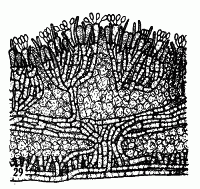|
![Go to the NZFungi website for more indepth information on Phlebia sp. [1].](../images/nzfungi_icon_ani.gif) Phlebia sp. [1] Phlebia sp. [1]
SynonymsCorticium bullatum
BiostatusPresent in region - Indigenous
Images (click to enlarge)
Caption: TEXT-FIG. 29. Corticium bullatum. x 500. |
Article: Cunningham, G.H. (1954). Thelephoraceae of New Zealand. Part III: the genus Corticium. Transactions of the Royal Society of New Zealand 82(2): 271-327.
Description: Hymenophore annual, closely adnate, chalky, effused, forming linear areas to 15 x 2 cm.;
surface cream, then alutaceous, sometimes tinted pallid heliotrope, finely colliculose, not
creviced; margin thinning out, concolorous, byssoid, adnate. Context white, 25-100 µ thick,
composed of a delicate basal layer of a few repent hyphae, and an intermediate layer of
mainly vertical hyphae embedded in masses of crystals; generative hyphae 3-4 µ diameter,
wall 0.2 µ thick, crystal coated, hyaline, branched, septate, with clamp connections. Hymenial
layer to 20 µ deep, of basidia, paraphyses and paraphysate hyphae. Basidia subclavate, 8-12 x
3-5 µ, 4-spored; sterigmata slender, to 5 µ long. Paraphyses subclavate, smaller than the
basidia. Paraphysate hyphae cylindrical with rounded apices, or acuminate, projecting. Spores
elliptical, 3-4.5 x 2-2.5 µ, wall smooth, hyaline, 0.2 µ thick.
Habitat: HABITAT. Effused on bark or decorticated decaying wood.
Distribution: DISTRIBUTION. New Zealand.
Notes: Crystals are produced in such masses as to obscure tissues completely. They are packed
between hyphae, coat them, alid extend to the hymenium masking basidia and paraphyses.
The context develops first as a tenuous layer of densely compacted hyphae. Among these
crystals appear, and about the time basidia are formed develop as lenses among the hyphae,
compressing them. Lenses gradually increase in size until blisters are formed which force the
hymenial layer upwards above the surface level. Finally this ruptures and the crystal masses
become exposed, giving plants a blistered, chalky appearance. In the collection from
Nothofagus fusca, spores are appreciably larger, some being 7 x 3 µ; but as it agrees with the
type in other features, it has been included herein.
Article: Stalpers, J.A. (1985). Type studies of the species of Corticium described by G.H. Cunningham. New Zealand Journal of Botany 23(2): 301-310 (http://www.rsnz.org/publish/abstracts.php).
Notes: = Phlebia sp.
The species turns red in KOH, causes a white rot and belongs to Phlebia Fr. The type material
was difficult to study and did not show much detail. However, some thin-walled encrusted
cystidia were seen. Spores were not observed. The species is close to or identical with Ph.
chrysocreas (Berk. & Curt.) Burdsall. Cunningham gave the spore dimensions as 3-4.5 x 2-2.5
µm, which is smaller than typical Ph. chrysocreas (4-5.5 x 2-2.5 µm).
|